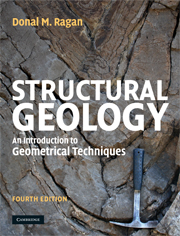Book contents
- Frontmatter
- Contents
- Preface
- Acknowledgements
- 1 Structural planes
- 2 Thickness and depth
- 3 Lines and intersecting planes
- 4 Planes and topography
- 5 Stereographic projection
- 6 Rotations
- 7 Vectors
- 8 Faults
- 9 Stress
- 10 Faulting
- 11 Deformation
- 12 Strain
- 13 Flow
- 14 Folds
- 15 Parallel folds
- 16 Similar folds
- 17 Folds and topography
- 18 Structural analysis
- 19 Tectonites
- 20 Drill hole data
- 21 Maps and cross sections
- 22 Block diagrams
- Appendices
- References
- Index
10 - Faulting
Published online by Cambridge University Press: 05 June 2012
- Frontmatter
- Contents
- Preface
- Acknowledgements
- 1 Structural planes
- 2 Thickness and depth
- 3 Lines and intersecting planes
- 4 Planes and topography
- 5 Stereographic projection
- 6 Rotations
- 7 Vectors
- 8 Faults
- 9 Stress
- 10 Faulting
- 11 Deformation
- 12 Strain
- 13 Flow
- 14 Folds
- 15 Parallel folds
- 16 Similar folds
- 17 Folds and topography
- 18 Structural analysis
- 19 Tectonites
- 20 Drill hole data
- 21 Maps and cross sections
- 22 Block diagrams
- Appendices
- References
- Index
Summary
Introduction
An important goal of structural geology is to determine the nature of the stress field together with the mechanical properties of the rock material at the time of the formation of structures. In the case of faults, some of this information may be obtained by combining data obtained from experiments with a detailed field study of their geometrical features.
Experimental fractures
To learn how rocks behave under various states of stress it is necessary to perform experiments which reproduce natural conditions as closely as possible. Ideally, the magnitudes of all three principal stresses should be independently controlled, but this is difficult to accomplish. In the conventional triaxial test a load is applied to the ends of a carefully prepared cylinder of rock jacketed with copper foil and immersed in a pressurized fluid. In this configuration, σ1 is parallel to the axis of the cylinder. The magnitudes of the other two principal stresses are equal to the pressure in the confining medium and this is commonly termed the confining pressure.
At low confining pressures the rock specimen fractures and there are two types: extension fractures perpendicular to σ3 (Fig. 10.1a) or shear fractures related to but not identical with the planes of maximum shearing stress. If fracture occurs before permanent distortion, the material is brittle (Fig. 10.1b); if a small permanent distortion (≤5%) precedes fracturing, it is semi-brittle (Fig. 10.1c).
- Type
- Chapter
- Information
- Structural GeologyAn Introduction to Geometrical Techniques, pp. 240 - 268Publisher: Cambridge University PressPrint publication year: 2009



